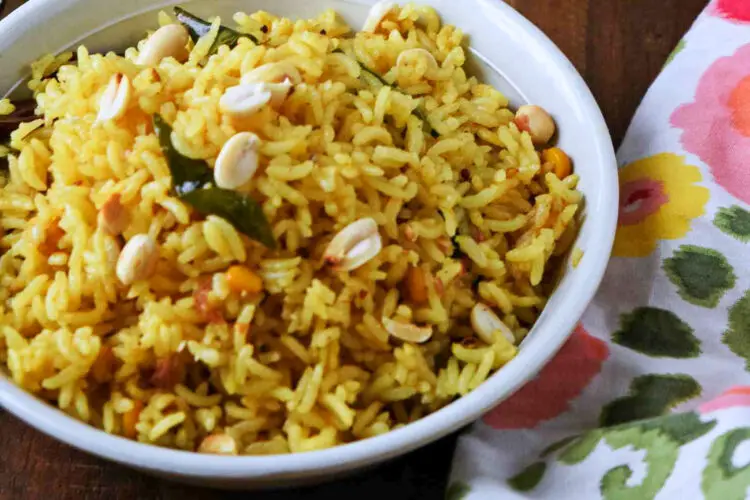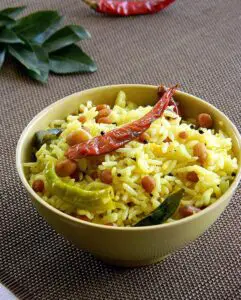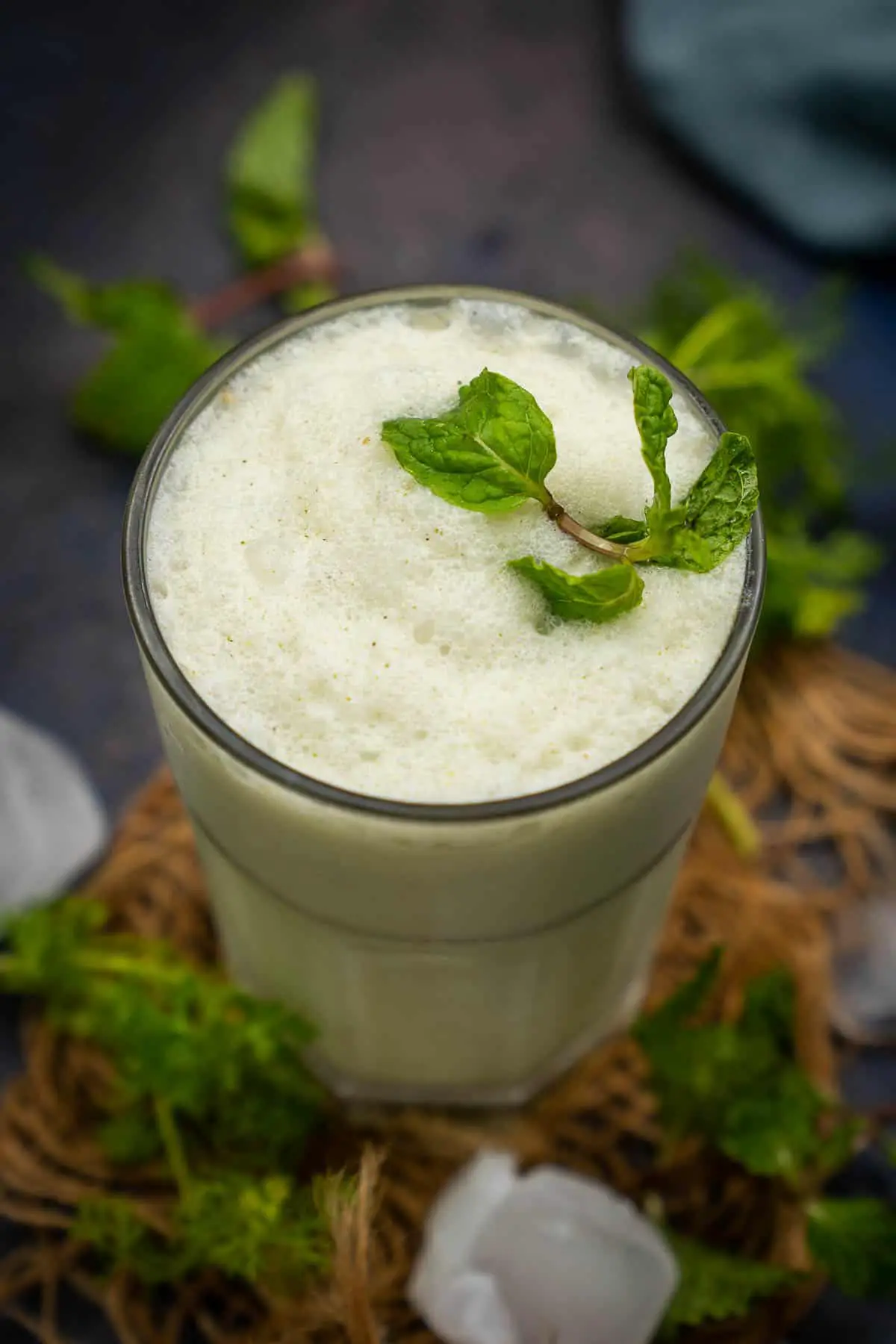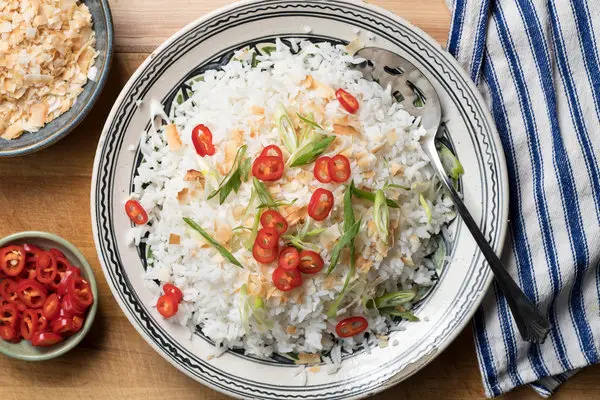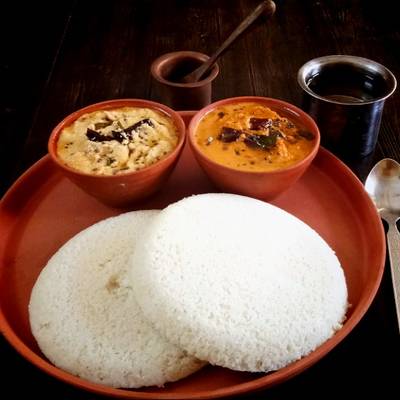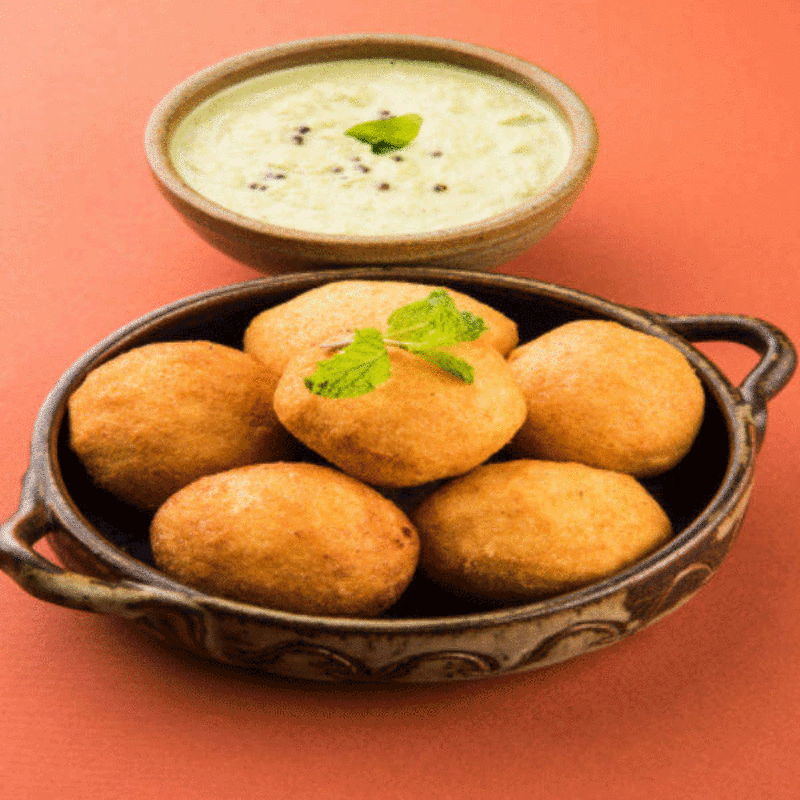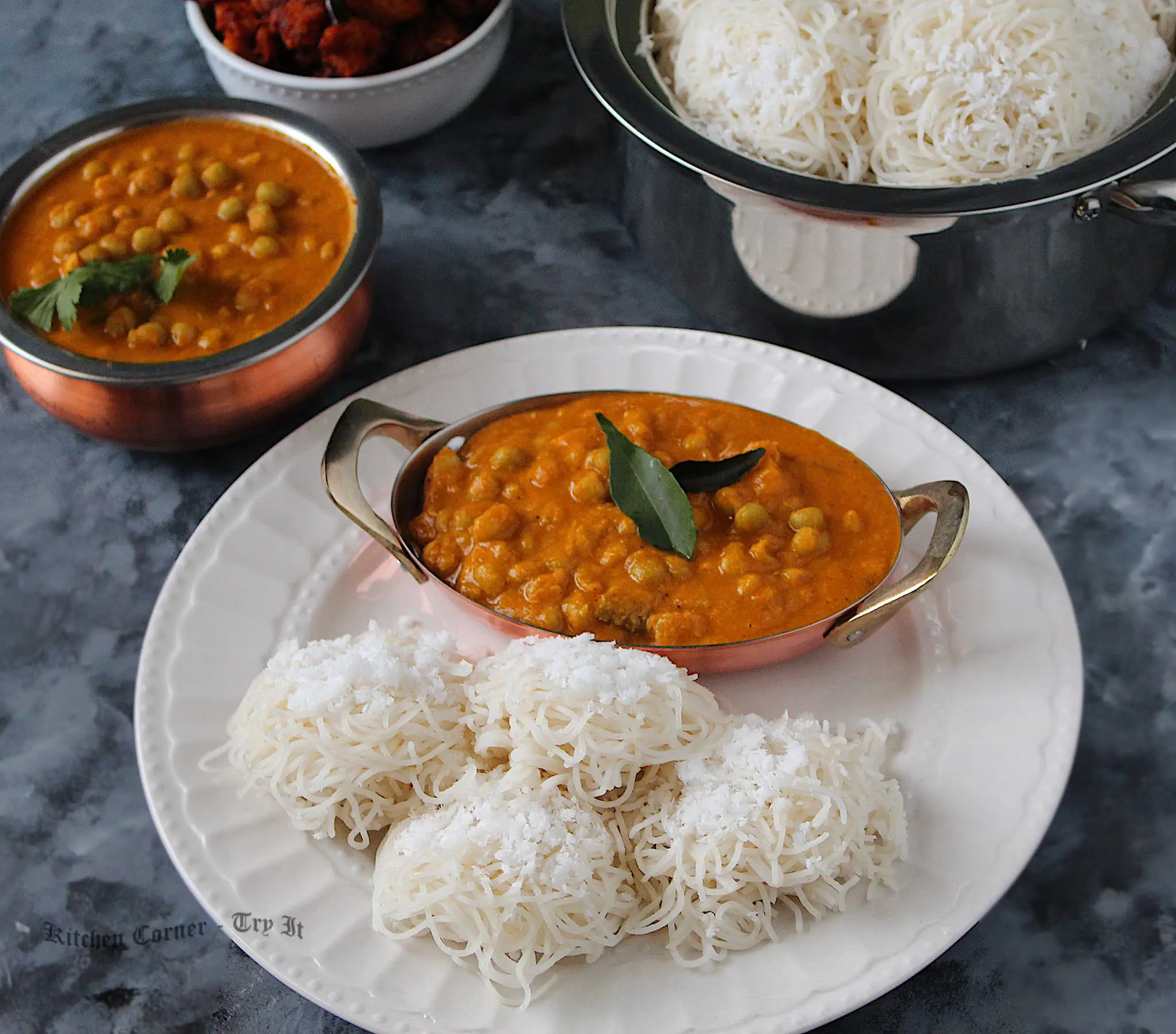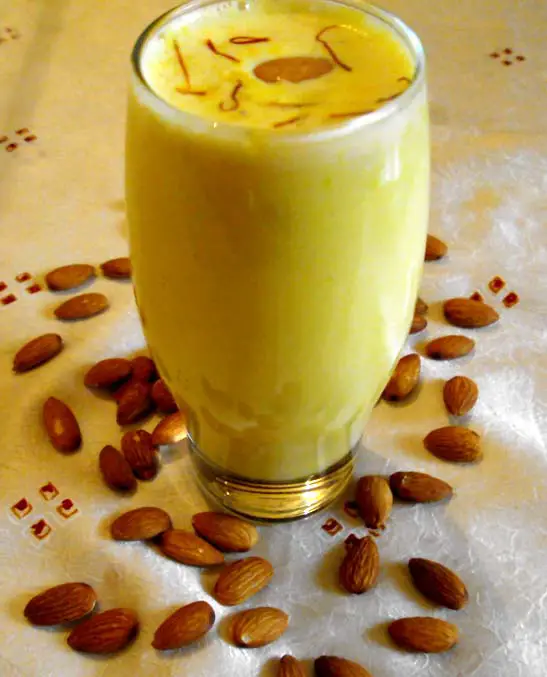Pulihora is a traditional South Indian dish that is typically made by mixing cooked rice with a tangy tamarind paste and other spices. It is a popular dish served during festivals, weddings, and other special occasions.
The tamarind paste is the key ingredient that gives Pulihora its unique tangy flavor. The rice is cooked separately and then mixed with the tamarind paste and a blend of spices, such as mustard seeds, cumin seeds, turmeric powder, and red chili powder.
The dish is often garnished with roasted peanuts, sesame seeds, and fresh coriander leaves for added crunch and flavor. Pulihora can be enjoyed as a main course or as a side dish, and it is typically served with other traditional South Indian dishes such as sambar, rasam, or curries.
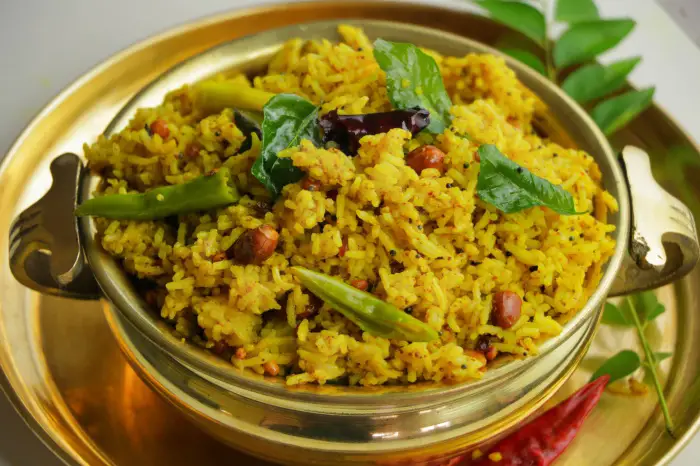
Ingredients for Pulihora:
- 2 cups cooked rice
- 1/4 cup tamarind paste
- 1/4 cup peanuts
- 1/4 cup sesame seeds
- 2 tablespoons oil
- 1 teaspoon mustard seeds
- 1 teaspoon cumin seeds
- 1/2 teaspoon turmeric powder
- 1/2 teaspoon red chili powder
- 1/4 teaspoon asafoetida
- Curry leaves
- Salt to taste
Instructions for Pulihora:
- In a pan, dry roast the peanuts and sesame seeds until golden brown. Set them aside.
- Heat oil in the same pan, and add mustard seeds and cumin seeds. Allow them to crackle.
- Add curry leaves, asafoetida, turmeric powder, and red chili powder. Stir well.
- Add tamarind paste, salt, and 1/4 cup water to the pan. Mix well and cook until the tamarind paste thickens.
- Add the roasted peanuts and sesame seeds to the pan and mix well.
- Add the cooked rice to the pan and mix it with the tamarind paste and spices until it is evenly coated.
- Cover the pan with a lid and let it simmer for 2-3 minutes until the rice is heated through.
- Garnish with some fresh coriander leaves and serve hot.
Your Pulihora is ready to be enjoyed as a tasty, tangy meal or snack.
Serving Suggestions
- Serve it with papad or chips: Pulihora goes well with crispy papad or chips. You can also serve it with fried items like vada or samosas.
- Add some yogurt: A dollop of yogurt on the side can help balance the tanginess of the tamarind in the pulihora.
- Pair it with a side dish: Pulihora can be served with a side dish like chutney or pickle. Coconut chutney, tomato chutney, or mango pickles are good options.
- Top with roasted cashews: Toasted cashews can add a nice crunch and nutty flavor to pulihora. You can sprinkle them on top just before serving.
- Serve as a part of a meal: Pulihora can be served as part of a larger meal, along with other dishes like sambar, rasam, and curries.
Tips and Variations
- Use good quality rice: The quality of the rice you use can have a big impact on the texture. Use good quality, long-grain rice for best results.
- Cook the rice correctly: Be sure to cook the rice properly so that it’s not too mushy or too dry. the rice should be cooked slightly firm so that it doesn’t turn into a paste when mixed with the spices.
- Soak the tamarind properly: Soak the tamarind in hot water for at least 15-20 minutes before extracting the pulp. This will make it easier to extract the pulp and also give a better flavor.
- Toast the spices: Toasting the spices before adding them to the dish will help release their flavor and aroma, making it more flavorful.
- Use fresh ingredients: Using fresh ingredients like curry leaves, ginger, and green chilies will give a fresher and more vibrant taste.
- Adjust seasoning as needed: Taste before serving and adjust the seasoning as needed. You may need to add more salt or tamarind depending on your personal taste preferences.
FAQs
- What are the key ingredients?
The key ingredients are rice, tamarind, curry leaves, mustard seeds, turmeric, and a variety of other spices like cumin, coriander, and red chili powder. Some variations of the dish may also include peanuts, green chilies, and ginger.
- Is pulihora gluten-free?
Yes, pulihora is typically gluten-free as it is made with rice and does not contain any wheat or other gluten-containing grains. However, if you are unsure, it’s always best to check the labels of any packaged ingredients you use to make sure they are gluten-free.
- pulihora be made in advance?
Yes, pulihora can be made in advance and stored in the refrigerator for up to 2-3 days. You may need to add a little water or oil to the rice before reheating it to prevent it from drying out.
- Can this be frozen?
Yes, pulihora can be frozen for up to 2-3 months. To freeze, portion the pulihora into individual servings and place them in airtight containers or freezer bags. Thaw in the refrigerator overnight before reheating.
- What are some variations?
There are many variations, including lemon pulihora, coconut pulihora, and tamarind-less pulihora. Each variation has a slightly different flavor and may use different spices and ingredients.
Your Pulihora is now ready to be served. Traditionally, it’s garnished with some freshly chopped coriander leaves for added freshness and flavor. You can also enjoy it with a side of yogurt or a South Indian pickle for an authentic experience.
Conclusion
In conclusion, Pulihora is not just a dish; it’s a culinary journey through the rich and diverse flavors of South India. Its unique combination of tangy tamarind, spicy seasonings, and the nutty crunch of peanuts makes it an absolute delight for the taste buds.
By following this detailed recipe, you can recreate the magic of Pulihora in your own kitchen. Impress your family and friends with this traditional South Indian dish that’s bursting with flavor and history.
Nutrition
- Calories: 143
- Protein: 2 grams
- Fat: 2 grams
- Carbohydrates: 29 grams
- Fiber: 2 grams
- Sugar: 1 gram
- Sodium: 189 milligrams
Pulihora Recipe: A Delicious Journey Through South Indian Flavors
Recommended Products
As an Amazon Associate and member of other affiliate programs, I earn from qualifying purchases.
You Might Also Like:
- Bharwa mirch achar recipe
- Amrood (guava) ki Sabji recipe
- A Paneer Chili recipe
- Veg Pulao recipe
- Bajra paratha recipe
follow us on instagram, facebook and youtube

